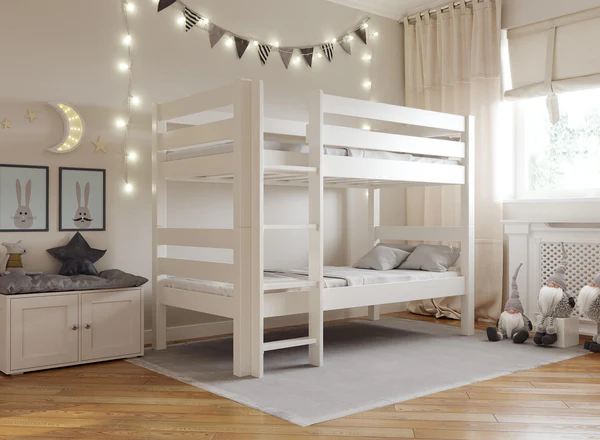
Bunk beds are a popular choice for children’s rooms because they save space, provide extra sleeping arrangements, and can even make bedtime more exciting. However, with so many styles, features, and materials to choose from, it can be tricky to find the perfect bunk bed that suits both your child’s needs and the layout of their room.
Here’s a guide to help you choose the right bunk bed for your child’s room.
1. Consider the Room Size
Before you start shopping for a bunk bed, it’s important to assess the available space in your child’s room. Bunk beds come in various sizes, from traditional twin-sized to full-sized beds, so the dimensions of the bed will significantly impact the room’s layout.
Measure the available floor space to ensure the bunk bed will fit comfortably while leaving room for other essential furniture like a dresser, desk, or play area.
Tip:
Leave enough space around the bed for easy movement. Consider the height of the bunk bed and ensure there’s enough clearance between the top bunk and the ceiling, especially for growing children.
2. Choose the Right Material
Bunk beds come in a variety of materials, with wood and metal being the most common. The material you choose will affect the overall look, durability, and price of the bed.
- Wooden Bunk Beds: These are classic, sturdy, and versatile. Wooden beds are available in a range of finishes and can easily match different room styles. They’re also usually quieter than metal beds, as they don’t creak as much.
- Metal Bunk Beds: Metal frames are often more modern in appearance and tend to be lighter and more affordable than wooden ones. They are typically more durable and easy to clean but may not offer the same warmth as wood.
Tip:
Consider the durability of the material based on your child’s age and how long you plan to keep the bed. Wooden frames tend to be more durable in the long run, while metal beds might be better for younger children.
3. Safety Features Are Key
Safety is the top priority when selecting a bunk bed for a child’s room. Bunk beds come with various safety features that ensure your child is safe while sleeping and playing.
- Guardrails: Ensure the top bunk has sturdy guardrails on both sides to prevent accidental falls. The guardrails should extend at least 5 inches above the mattress.
- Ladder Design: Look for a ladder that is easy for your child to climb. Some ladders are angled, while others are straight. If your child is younger, consider a ladder with wide steps for better grip.
- Weight Capacity: Check the weight limit for both the top and bottom bunks to make sure it suits your child’s current size and any future needs. If the bed is for multiple children, choose a model with a higher weight capacity.
Tip:
For younger children, some bunk beds come with additional safety features like shorter heights or removable guardrails, which can offer extra peace of mind.
4. Determine the Bed Layout
Bunk beds come in several layouts, so think about the best configuration for your space and your child’s needs:
- Traditional Bunk Beds: These have one bed stacked directly above the other, which is the most common and space-efficient option.
- Lofted Beds: In this design, the top bed is raised higher off the ground, allowing for more space underneath the bed for a play area, desk, or storage. This works well for older children who don’t need the bottom bunk for sleeping.
- L-Shaped or Corner Bunk Beds: These beds are arranged in an “L” shape, with the bottom bunk extending perpendicular to the top bunk. This layout can be ideal for rooms with limited space and adds a unique design element.
- Futon Bunk Beds: These feature a bottom bunk that doubles as a couch or futon, making them perfect for smaller rooms where space is at a premium. The futon can be converted into a sitting area during the day and a sleeping space at night.
Tip:
Consider your child’s lifestyle and how the bed will be used. If your child enjoys having friends over, an L-shaped or futon bunk bed may be more practical for hosting sleepovers.
5. Consider Your Child’s Age and Needs
The age of your child will play a big role in determining the right bunk bed. For younger children, it’s essential to choose a bed with a low height and additional safety features like sturdy guardrails. For older children, you may want to focus on a bed that suits their personal style or allows for more functionality, such as storage or a study space.
- For Younger Kids: Choose a low-profile bunk bed with guardrails that make it easy for them to access the top bunk. Avoid beds with high ceilings if your child is still young.
- For Older Kids: You might want to opt for a more grown-up design that features additional storage, a lofted bed with a study area underneath, or a bunk bed with a trundle for sleepovers.
Tip:
Keep in mind that bunk beds are typically recommended for children over the age of 6 to ensure safety on the top bunk.
6. Add Storage Options
In small rooms, storage is often just as important as sleeping space. Many bunk beds are designed with built-in storage to help you make the most of every inch of space.
- Under-Bed Drawers: Some bunk beds come with drawers under the bottom bunk to store clothes, toys, or bedding.
- Shelving and Desks: Look for beds with integrated shelving units, desks, or even chairs under the bottom bunk. This adds functionality without cluttering the room with extra furniture.
- Trundle Beds: If your child often has guests over, a bunk bed with a trundle underneath can be a great way to provide additional sleeping space without taking up extra room.
Tip:
Storage is crucial in smaller rooms, so look for bunk beds with built-in options like drawers, shelves, or a trundle bed to maximize storage capacity.
7. Think About Style
While functionality is essential, you’ll also want a bunk bed that fits your child’s personality and the room’s decor. Bunk beds come in a wide variety of styles, from modern and minimalistic to more traditional and whimsical designs.
- For a Modern Look: Choose sleek metal or wooden bunk beds with clean lines and simple finishes.
- For a Fun Theme: Consider beds that incorporate playful features like a castle-shaped frame or themed designs (e.g., cars, animals, or nautical themes).
- For Versatility: Opt for neutral colors or finishes that can easily transition as your child grows.
Tip:
Incorporating your child’s favorite colors or themes can make the room feel more personalized, helping them feel more comfortable and excited about their new bed.
Conclusion
Choosing the right bunk bed for your child’s room involves balancing safety, space, style, and functionality. Take the time to measure the room, consider the best material and layout, and think about your child’s age and needs.
With the right bunk bed, you can create a fun, functional, and safe sleep environment that works perfectly for your child’s room and enhances their space.





